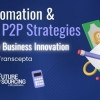Before discussing the rewards available for a financial services organisation in the cloud it is important to get an understanding of the regulatory backdrop. In October 2014 the Financial Conduct Authority (FCA) launched Project Innovate, an initiative to foster innovation in the cloud. The key driver behind this project was to understand in more detail where the regulatory framework needed to be amended in order to foster innovation. The UK government and the FCA have broadly recognised that in order to foster innovation and remain at the leading edge of the financial services industry, innovation needs to be embraced and promoted. Interestingly it is often down to the location and movement of data that the cloud encourages that drives some of the regulatory challenges.
Indeed, the FCA defined the following three points as significant:
- Cloud customers may have less scope to tailor the service provided.
- Cloud customers may also have to accept that cloud service providers will move their data around; however, in some cases, cloud customers may be able to specify which overall geographic region in which their data is stored.
- Firms should also consider the risks associated with outsource service providers who may contract out part of their operation to other cloud providers. This may occur without the firm initially realising.
Companies should also be aware of new legislation and how it impacts a move to the cloud, specifically new EU Digital Single Market strategy and the reform of EU data protection legislation. The exact form of the cloud service adopted, whether PaaS, SaaS, IaaS or another flavour of cloud does not change how an organisation adheres to regulatory requirements — and when outsourcing to a third party, the organisation must still be aware of their obligations under the relevant regulations.
Despite the significance of the three points identified by the FCA, the financial technology industry in the UK is already booming and offers some of the larger financial organisations a view of how cloud can deliver genuine rewards.
So with the backdrop of a heavily regulated industry, albeit one that is trying to incorporate cloud, how do new and traditional organisations begin the lengthy process of unlocking benefits in the cloud — benefits already realised in other less regulated markets such as content and digital media.
The answer lies not in adopting a “just cloud” strategy but in pursuing the goal of hybrid IT. Hybrid IT is defined as an approach to enterprise computing in which an organisation provides and manages some IT resources in-house but uses cloud-based services for others. When talking about cloud the first thing that often comes to mind is the public cloud providers and, from an enterprise perspective, how this pillar is being adopted today. In Q1 2015 AWS reported revenues of £1.57bn, just slightly more than the sum of its four nearest competitors Salesforce, Microsoft, IBM and Google.
With a public cloud market of more than $3bn in Q1 alone, it is reasonable to suggest that financial services organisations are no different to other industries where shadow IT and un-regulated use of public cloud services are prevalent. Many businesses today are aware of the challenges of managing shadow IT in their organisations, but also recognise that public cloud could form a cornerstone of their IT strategy. Hybrid IT offers organisations the opportunity to incorporate public cloud into the IT strategy where appropriate. The challenge for financial services organisations is to understand their application portfolio in detail and to overlay regulatory requirements on top of those applications. Other industries can often approach this piece of work from a different angle, that is, decided which applications are cloud-ready, but financial services organisations need to ensure that regulatory requirements are also met. Once applications have been classified according to cloud readiness and adherence to regulatory requirements it is possible to build a hybrid IT strategy where certain applications can be migrated to the cloud.
It is the adoption of a hybrid strategy that will deliver the most significant benefits to financial services organisations. In the past some organisations have treated the move to the cloud as a binary decision: they will or they won’t. The complexities of managing multiple IT environments will not go away, however, and technologies that allow you to move workloads effectively and efficiently across multiple IT environments are becoming more readily available. Imagine if your hybrid IT environment consisted of access to a public cloud for cheap, flexible compute. Your revenue-generating applications are managed by your organisation in a colocated environment as you do not wish to lose control. Regulated applications sit in the cloud with a third-party cloud provider to ensure data location and for longer-term projects your third-party provider offers an enterprise cloud. It is when all these clouds align that you will reap the rewards of migrating to the cloud.









